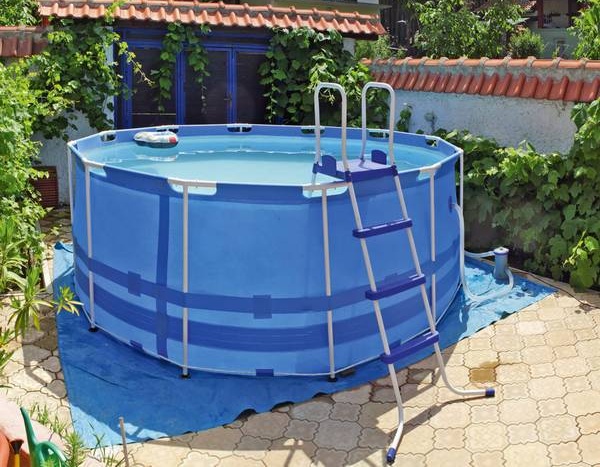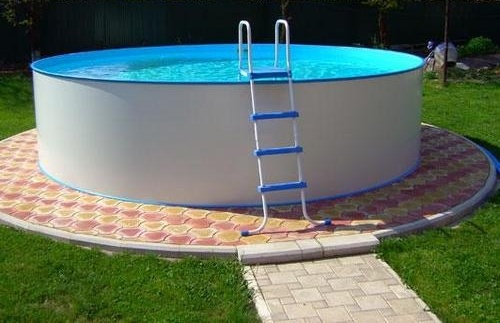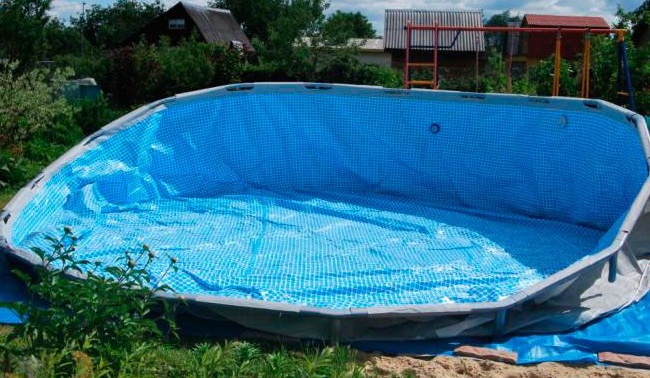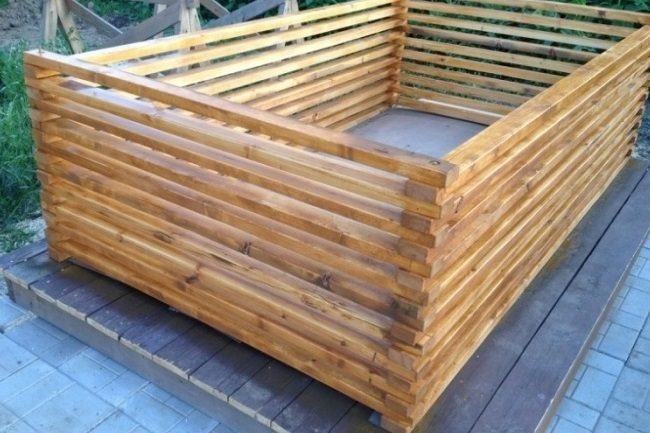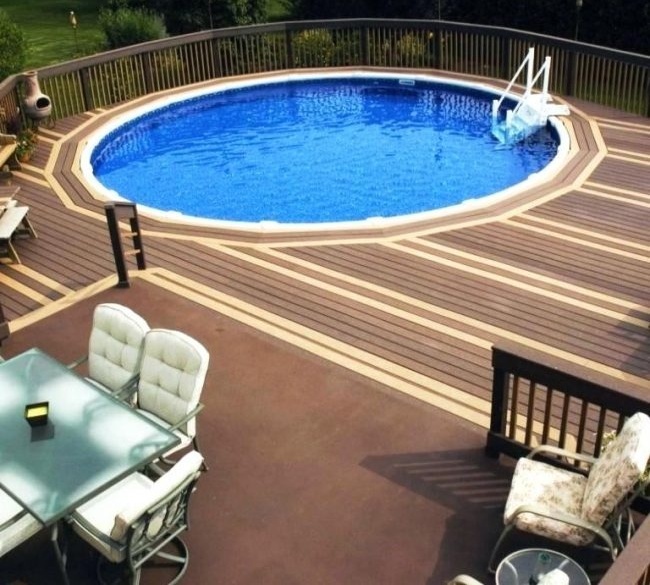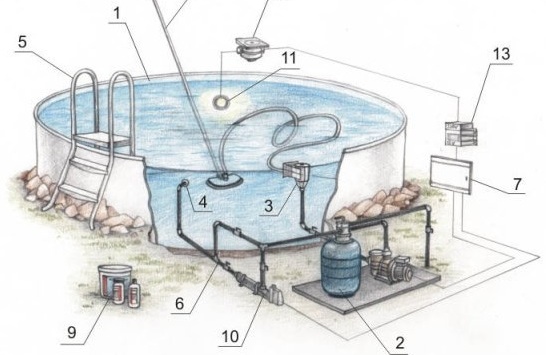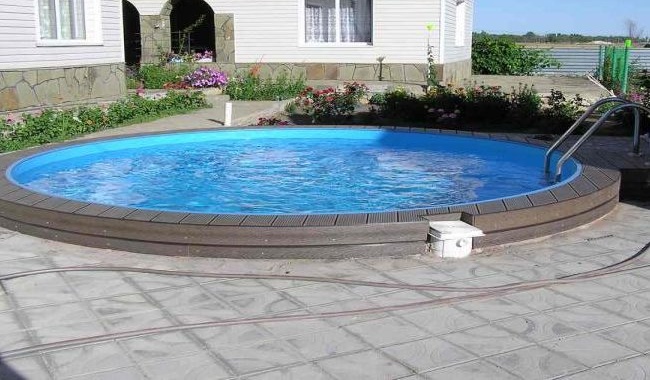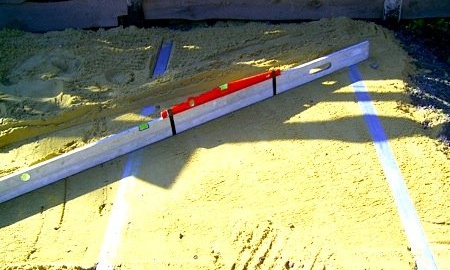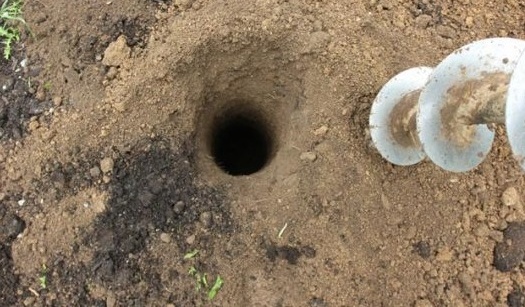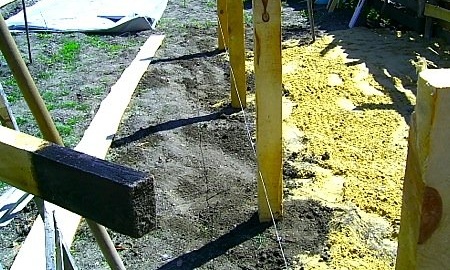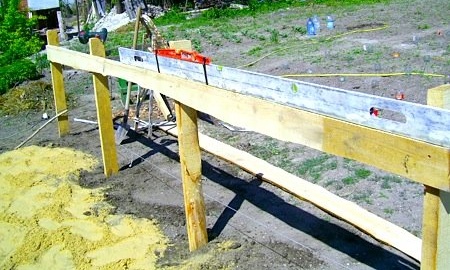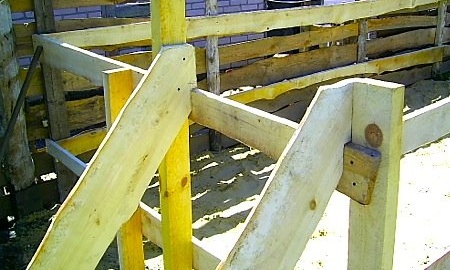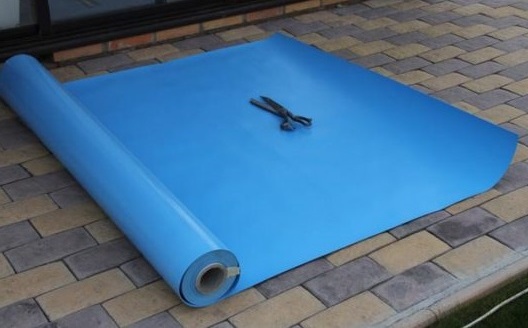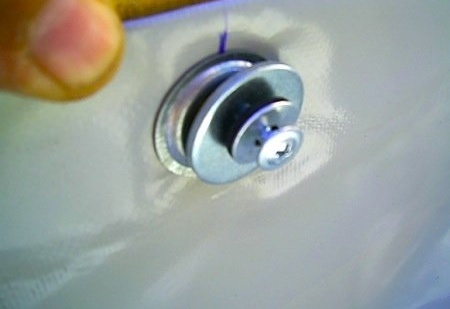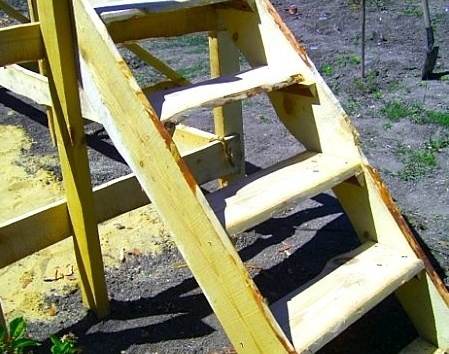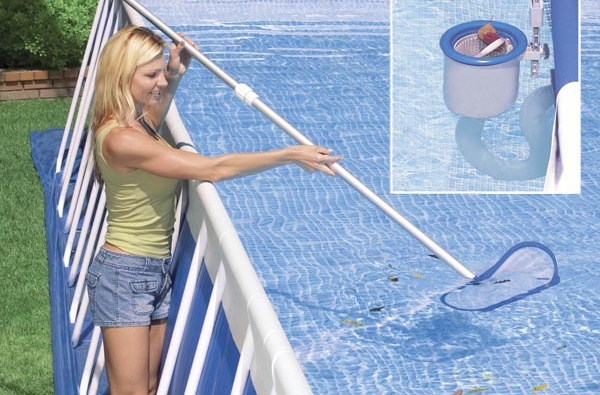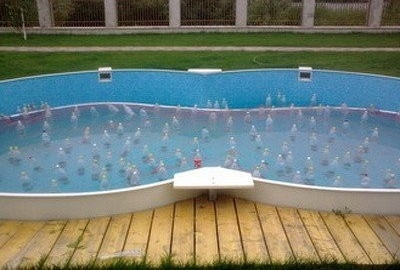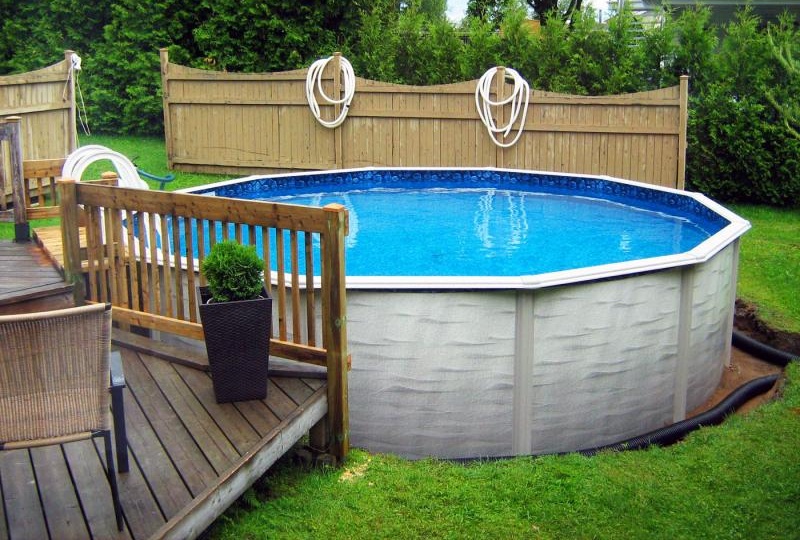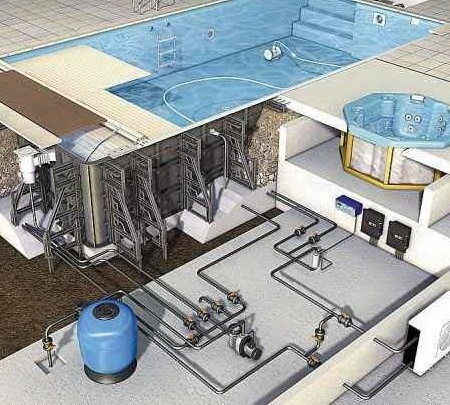How to make a frame pool in the country with your own hands
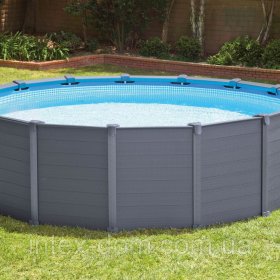
Artificial reservoirs in the form of collapsible structures have sufficient rigidity due to the technical characteristics of plastic or composite materials. To make a frame pool with your own hands, you need to carefully approach the issues of choosing the type of design and the materials used.
Content
Advantages and disadvantages of frame structures
Collapsible structures based on the frame have many advantages:
- resistance of the surface of the bowl to mechanical damage;
- preservation of working qualities under the influence of sunlight and low temperature conditions;
- wide choice of models;
- relative compactness and mobility;
- Long service life exceeding ten years;
- intuitive ease of installation even with a slope of the surface up to 20º;
- ease of maintenance;
- the ability to perform self-assembly and disassembly.
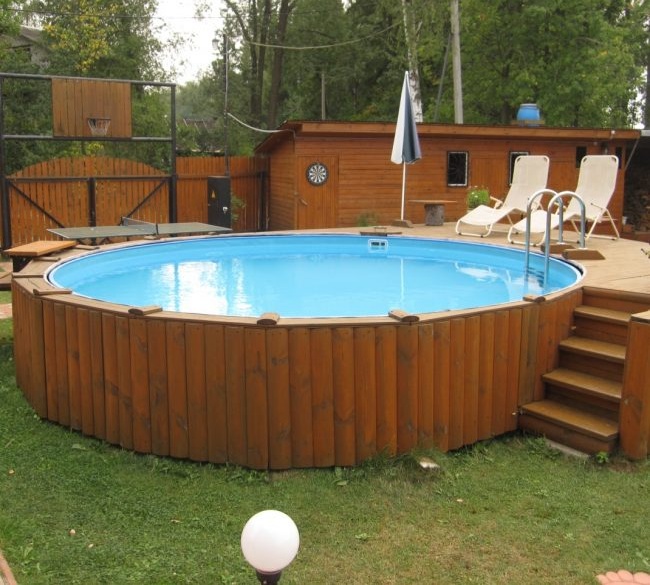
Finishing with a terrace board or wood siding successfully combines with other buildings and a fence
Unstable to frost models must be dismantled and stored for storage with the onset of late autumn, since in conditions of sharply negative temperatures they deform and crack. The most significant drawback of the factory-made frame pool is its rather high cost.
Types of frame pools
Absolutely all varieties of frame pools belong to the category of collapsible structures. The first option is represented by rod models based on vertically or horizontally positioned galvanized steel rails. Sectional views are characterized by the presence of modules made of metal or high-strength plastic, bolted together with a lock connection.
By type of construction
Depending on typical features, all artificial reservoirs based on a frame structure are divided into models of the rod and sheet type. Both varieties produced by domestic and foreign manufacturers are equipped with a convenient and reliable staircase.
The frame base is represented by a set of crossbars and special ribs of increased rigidity used to fix the film elements of the walls of an artificial reservoir. Rod products do not need to carry out serious excavation and construction work in the area allocated for installation. Advantages are quick self-assembly and disassembly, as well as a sufficiently high strength. Nevertheless, core models are characterized by relatively shallow depth.
Installation of sheet models is more time-consuming compared to the installation of rod-type frames, but it is such artificial reservoirs that are more durable and capital. Sheet-type products can be equipped with different mounting methods, including “lock-to-lock”, as well as bolted connections and design models. Frame sheets give increased rigidity and reliability to the entire wall structure. The main advantages of any leaf pools are also ease of maintenance, including regular cleaning.
By seasonality
Frame hydraulic collapsible structures can be frost-resistant, and also designed exclusively for seasonal use. The average life of such pools, subject to proper maintenance, is about ten years.
All-weather or frost-resistant, mainly stationary pools on the frame do not need to be disassembled before the onset of frost. Due to the presence of a metal side, a reinforced frame structure and a reliable enamel or polymer coating, simple preservation allows you to maintain the appearance and technical characteristics of the product even in severe frosts. The complete set of frost-resistant models is presented by installation instructions, a pumping unit with a filter, a bottom cover and a net, as well as a cover and a small but durable staircase. Modern models are equipped with a water vacuum cleaner to clean the bottom and walls.
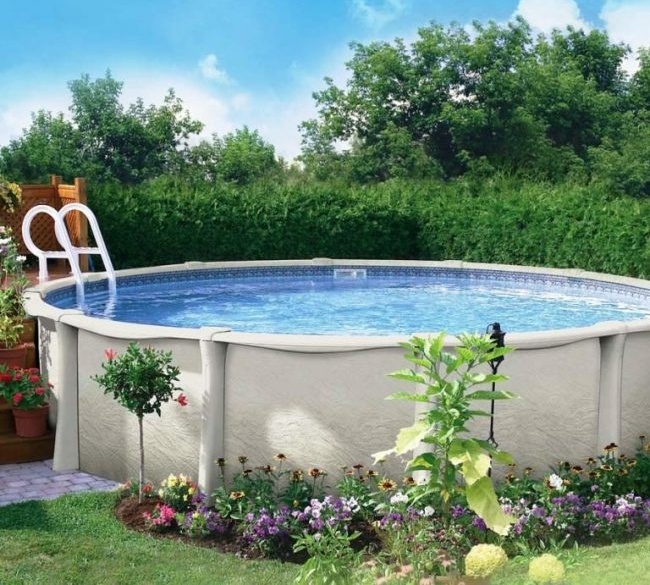
Models are produced that are not afraid of sub-zero temperatures and can be assembled all year round
Seasonal products must be collected before the summer and dismantled with a bookmark for storage immediately before the cold.
Such collapsible structures are very convenient and very practical, but most often designed for the simultaneous bathing of a small number of people. The frame base is represented by metal, hollow pipes and connecting elements, with which, as a rule, a three-layer polyvinyl chloride bowl is supplemented. Round, rectangular or square shapes are the most popular, but you can also order the manufacture of products according to individual sketches.
What materials can be used for construction
Homemade frame pools have both certain advantages and some disadvantages, which is associated with the design features of such an artificial reservoir. Self-made hydraulic structures, as a rule, do not differ in large area, and are also characterized by quite noticeable difficulties in the installation of any maintenance equipment and the need to constantly monitor the condition of all elements.
The main building and finishing materials used for the manufacture of the frame pool are as follows:
- For the construction of the frame, wood treated with antifungal compounds, natural or artificial stone, metal racks are most often used.
- To equip the bowl, the most durable and reliable, only durable artificial materials are used, to which polyvinyl chloride deserves to be considered. Usually, in self-production, special fabrics are used, stretched to an already erected frame base.
- A highly worthy option for the design of the bowl will also be high-strength shields based on modern plastics.
- A variety of modern finishing materials are used for external cladding. Finishing the hydraulic structure outside is most often done using natural treated wood, including a special lining or terrace board. Also for this purpose, you can use natural or composite, waterproof materials, PVC panels and tiles, which are securely fixed to the crate.
For trimming the sides, the optimal solution would be to use functional coping or the so-called side stone, which has an anti-slip surface and high decorativeness. Such material protects the outdoor pool from overflow of water and the ingress of contaminants into the bowl. Coping can have gray, pink, white or beige staining, due to the color of marble chips, which is part of the raw material for the manufacture of side stones.
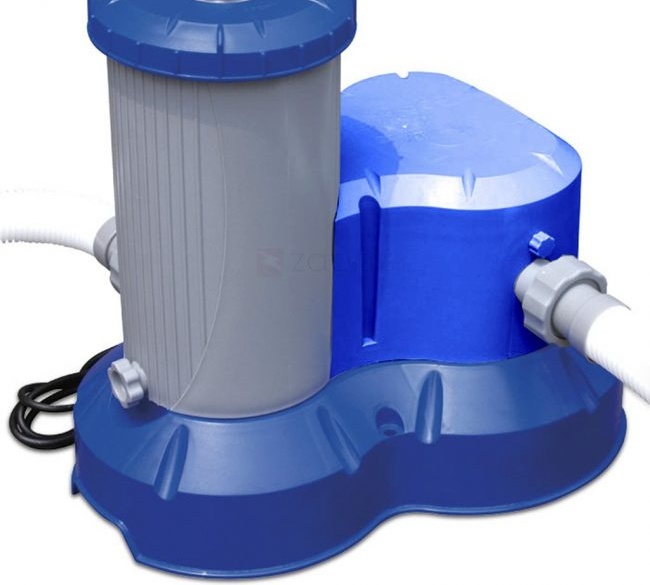
To filter large volumes of water, you will need to install several filters in different parts of the bowl
Artificial reservoirs can, if desired, be supplemented by an automatic filtration and disinfection system, water heating devices, as well as LED lighting.
Do not rush to get rid of old pallets and tires, because these improvised materials can be a good base for the construction of the pool. Step-by-step instructions in our article: https://aquatech.tomathouse.com/en/vodosnab/font_bass/basseyn-na-dache-svoimi-rukami.html.
How to build a pool with your own hands - step by step instructions with a photo
Independent construction of the pool helps to significantly save money, and also allows you to get a hydraulic structure with an individual appearance and optimal shape and size, in accordance with the site allocated for construction.
Preparatory stage
It is with preparatory measures that the construction of the frame pool begins. At this stage, not only competent project documentation should be developed and the amount of materials used to be calculated, but also the optimal place will be selected, all construction, decoration and fixing materials will be purchased, additional equipment will be purchased to service the hydraulic structure.
Drawing and dimensions
As a basis for project documentation, you can take a diagram of an already finished frame construction of an artificial reservoir, which includes the following elements:
- 1 - walls;
- 2 - filtering device;
- 3 - skimmer installation;
- 4 - nozzles;
- 5 - staircase construction;
- 6 - a system of pipes and fittings;
- 7 - electric automatic part;
- 8 - bottom vacuum cleaner;
- 9 - chemicals for water treatment;
- 10 - electric heating element;
- 11 - lighting system;
- 12 - junction box;
- 13 - transformer.
A list and the amount of required materials may be attached to the drawing.
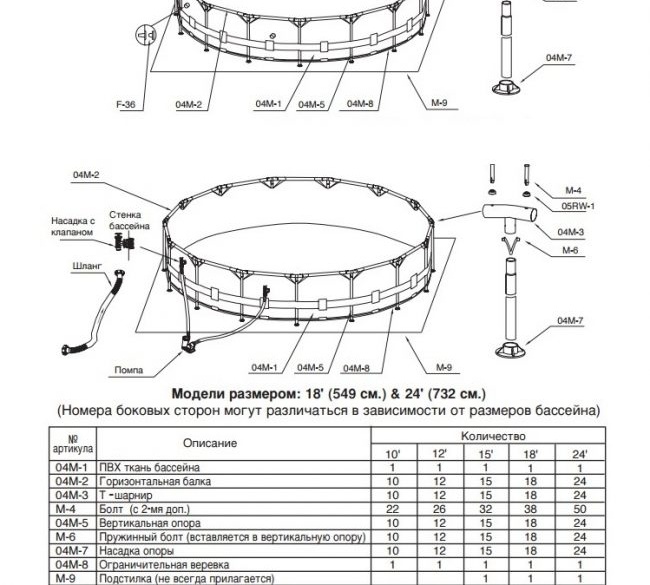
With such a ready-made scheme, you can immediately go to the construction store, the consumption of materials is indicated for different bowl sizes
Preparation of materials and tools
The main tools necessary for the construction of a frame pool:
- building hair dryer;
- Chipboard sheets or fiberboard;
- rolling rollers and eyelets;
- grinder and drill, strong rope,
- sand and gravel, sheet bitumen,
- rule and construction level;
- spade, tape measure;
- cement, sand, gravel;
The amount of PVC film depends on the shape and size of the manufactured structure:
- for a rectangular-shaped bowl with a flat bottom, the calculation of the floor area involves multiplying the length by width, and to obtain data on the walls, the perimeter of the walls should be multiplied with their height. For example: for a hydraulic structure with dimensions of 10 x 5 m and a half meter wall height, the floor area will be 50 m2, wall area - 45 m2, and the total area of the material is 95 m2;
- for a round bowl with a flat bottom, calculating the floor area involves multiplying the floor diameter by the floor diameter, and to obtain data on the walls, the perimeter of the walls should be multiplied with their height. For example: for a hydraulic structure with a diameter of 6 m with a wall height of 120 cm, the floor area will be 28.3 m2, wall area - 22.6 m2, and the total area of the material is 50.9 m2;
- for a rectangular-shaped bowl with a pyramidal bottom, calculating the floor area involves multiplying the length by width with a factor of "1.3", and to obtain data on the walls, it is necessary to multiply the perimeter with the height of the vertical wall. For example: for a hydraulic structure of 10 x 5 m with a vertical wall height of 120 cm, the floor area will be 65 m2, wall area - 36 m2and the total area of the tent material is 101 m2.
Site selection
When choosing a place for the construction of a hydraulic structure, it is necessary to pay attention to the following recommendations:
- the presence of a fairly flat surface without noticeable tubercles and differences in height;
- close proximity of the electric power source for trouble-free connection of pumping and filtering equipment;
- the availability of an accessible source of water supply to fill the bowl;
- the presence of a sewer system for discharging waste water.
The construction of the frame pool
Installation of a frame pool is quite affordable even for a novice builder, and materials are affordable. Having studied the installation technology and having followed all the steps accurately, the hardworking owner will receive a reliable and durable construction.
Base
The selected area should be flat, 1 m more than the bowl on each side.
Work Stages:
- Remove the top layer of loose soil and grass.
- Dig a pit with a depth of about 60 cm or more to deepen the reservoir, pour a layer of crushed stone with a thickness of 25-30 cm and a sand layer of at least 15 cm. Lay geotextiles between the layers to strengthen and level the site.
- As a base, you can use well-compacted soil or a light foundation with a bulk sand cushion 50 cm high, without filling the screed.
- If the screed is supposed, then you need to connect the reinforcement rods into the grate and install it on the supports, so that the reinforcement is in the thickness of the screed. Reinforce the mesh with a layer of cement mortar. Drying the base takes 2 weeks, after which you can lay a special substrate.
- At the corners of the leveled platform and on all sides of the fabricated frame, dig a hole with a depth of 50 cm using a drill.
- Install thermal insulation from polystyrene foam or other improvised materials, and on top a special substrate.
Frame construction
The frame base of an artificial reservoir is made of bars and boards carefully treated with antiseptic agents, and self-tapping screws and other fasteners should also be purchased. All lumber should be of high quality and well-dried.
Installation steps:
- The lower part of all racks of bars should be treated with bitumen mastic, and special attention should be paid to protecting the ends of such wooden elements from moisture.Set the processed bars in the drilled holes.
- At the next stage, it is necessary to provide the installed supporting bars with an upper strapping based on boards. Tying elements can be fixed with galvanized nails, but it is preferable to use self-tapping screws for this purpose.
- Stabilizing struts allow you to make the erected frame structure as reliable and durable as possible. Installed wooden supports must be securely fixed with nails or self-tapping screws.
- With a distance of half a meter from the corner of the frame, an additional stand is installed, and two boards are used to make a bowstring fixed to the support at the bottom.
Bowl mounting
- After the marking and cutting of the canvas are completed, the elements are welded using a building hair dryer. The welded film web is laid inside the finished frame structure and carefully straightened.
- To fix the stretched film web inside the artificial pond, special galvanized fasteners with a press washer are used.
Installation of stairs
For the manufacture of steps, a board is used, and the cut elements are installed with a standard distance of a quarter meter from each other using support bars.
External cladding and installation of equipment
After all the arrangements for arranging the inner part of the home-made frame pool are completed, you can proceed to the external decor of the hydraulic structure, finishing can be done with a terrace board, mosaic or ceramic tiles, natural or artificial stone, sheathed with polycarbonate or siding.
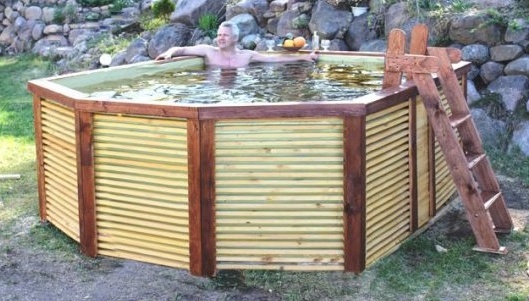
Wooden planks and boriks should be coated with two layers of varnish or paint on wood for outdoor use.
The functionality of the artificial reservoir is ensured by the installation of pumping and filtering equipment. Installation of equipment involves the installation of nozzles in the feed hole, as well as the placement of the bottom outlet in a special outlet. A sufficient amount of quartz sand is poured into the filter tank, after which a pressure sensor is connected to the valve.
Durable clamps are used to seal the bottom outlet and the suction hose of the filter equipment. Plastic couplings allow reliable connection of the return hose to the nozzle and the addition of the pressure hose to the pump outlet. One hose from the pump and the filter hose are discharged into the sewer system. After the pumping equipment is fully connected to the electric power supply system, a test set of water in the pool bowl and a thorough check of all connections should be performed.
Video: installing a frame tank under the pool
Video: frame pool assembly
Care Tips
After all the installation of the pool structure has been completed, it is necessary to monitor the functioning of the purification system by connecting it to the electrical network. Pumping equipment must qualitatively filter the full volume of water in the pool. Before starting the filling of the bowl with water, disinfection measures should be performed, since the pump is able to effectively cope mainly with mechanical impurities.
To prevent abundant overgrowing of the basin bowl with all kinds of algae, it is recommended to use special chemicals, but with monitoring the condition of the water.It is required to monitor the pH level once a week, and if abnormalities are detected, the data are aligned to optimal values with special drugs. It is important to remember that restoring a neglected hydraulic engineering structure is very expensive for its owner, so competent construction and regular disinfection should be ensured.
Particular attention is required to the timely process of preserving an artificial reservoir in the winter.
- To clean the pool bowl and internal parts should be a special vacuum cleaner, without draining the water, after which it will be necessary to carry out processing with chemical compounds.
- After the water is drained to a height of 80–100 mm, the pumping equipment components must be disconnected.
- To prevent too much volume expansion of the structure as a result of freezing, compensatory products are used that are half immersed in water.
- At the final stage, the mirror of the artificial pond is closed with a protective cover.
The cost and quality characteristics of ready-made frame pools produced by domestic and foreign manufacturers, as a rule, are quite comparable, but the price of such hydraulic structures is not always accessible to the average layman. For this reason, many owners of suburban real estate prefer the independent manufacture of a frame pool, which allows you to build a beautiful and original, and most importantly - budget design for a relatively short time.
